Exclusive ubiquitination and sumoylation on overlapping lysine residues mediate NF-kappaB activation by the human T-cell leukemia virus tax oncoprotein
- PMID: 16287853
- PMCID: PMC1291224
- DOI: 10.1128/MCB.25.23.10391-10406.2005
Exclusive ubiquitination and sumoylation on overlapping lysine residues mediate NF-kappaB activation by the human T-cell leukemia virus tax oncoprotein
Abstract
The transcription factor NF-kappaB is critical for the induction of cancer, including adult T-cell leukemia, which is linked to infection by human T-cell leukemia virus type 1 and the expression of its regulatory protein Tax. Although activation of the NF-kappaB pathway by Tax involves its interaction with the regulatory subunit of the IkappaB kinase (IKK) complex, NEMO/IKKgamma, the mechanism by which Tax activates specific cellular genes in the nucleus remains unknown. Here, we demonstrate that the attachment of SUMO-1 to Tax regulates its localization in nuclear bodies and the recruitment of both the RelA subunit of NF-kappaB and free IKKgamma in these nuclear structures. However, this sumoylation step is not sufficient for the activation of the NF-kappaB pathway by Tax. This activity requires the prior ubiquitination and colocalization of ubiquitinated Tax with IKK complexes in the cytoplasm and the subsequent migration of the RelA subunit of NF-kappaB to the nucleus. Thus, the ubiquitination and sumoylation of Tax function in concert to result in the migration of RelA to the nucleus and its accumulation with IKKgamma in nuclear bodies for activation of gene expression. These modifications may result in targets for the treatment of adult T-cell leukemia.
Figures
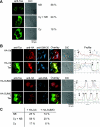
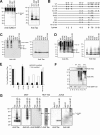
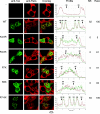
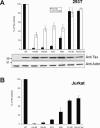
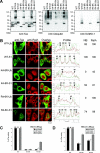
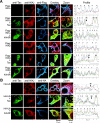

Similar articles
-
Low nuclear body formation and tax SUMOylation do not prevent NF-kappaB promoter activation.Retrovirology. 2012 Sep 25;9:77. doi: 10.1186/1742-4690-9-77. Retrovirology. 2012. PMID: 23009398 Free PMC article.
-
Ubiquitination and sumoylation of the HTLV-2 Tax-2B protein regulate its NF-κB activity: a comparative study with the HTLV-1 Tax-1 protein.Retrovirology. 2012 Dec 7;9:102. doi: 10.1186/1742-4690-9-102. Retrovirology. 2012. PMID: 23217160 Free PMC article.
-
An alternative splice product of IkappaB kinase (IKKgamma), IKKgamma-delta, differentially mediates cytokine and human T-cell leukemia virus type 1 tax-induced NF-kappaB activation.J Virol. 2006 May;80(9):4227-41. doi: 10.1128/JVI.80.9.4227-4241.2006. J Virol. 2006. PMID: 16611882 Free PMC article.
-
The multifaceted oncoprotein Tax: subcellular localization, posttranslational modifications, and NF-κB activation.Adv Cancer Res. 2012;113:85-120. doi: 10.1016/B978-0-12-394280-7.00003-8. Adv Cancer Res. 2012. PMID: 22429853 Review.
-
Activation of I-kappaB kinase by the HTLV type 1 Tax protein: mechanistic insights into the adaptor function of IKKgamma.AIDS Res Hum Retroviruses. 2000 Nov 1;16(16):1591-6. doi: 10.1089/08892220050193001. AIDS Res Hum Retroviruses. 2000. PMID: 11080796 Review.
Cited by
-
SQSTM-1/p62 potentiates HTLV-1 Tax-mediated NF-κB activation through its ubiquitin binding function.Sci Rep. 2019 Nov 5;9(1):16014. doi: 10.1038/s41598-019-52408-x. Sci Rep. 2019. PMID: 31690813 Free PMC article.
-
Role of post-translational modifications of HTLV-1 Tax in NF-κB activation.World J Biol Chem. 2010 Jan 26;1(1):13-20. doi: 10.4331/wjbc.v1.i1.13. World J Biol Chem. 2010. PMID: 21540989 Free PMC article.
-
HSP90 protects the human T-cell leukemia virus type 1 (HTLV-1) tax oncoprotein from proteasomal degradation to support NF-κB activation and HTLV-1 replication.J Virol. 2013 Dec;87(24):13640-54. doi: 10.1128/JVI.02006-13. Epub 2013 Oct 9. J Virol. 2013. PMID: 24109220 Free PMC article.
-
SUMO-interacting motifs of human TRIM5α are important for antiviral activity.PLoS Pathog. 2011 Apr;7(4):e1002019. doi: 10.1371/journal.ppat.1002019. Epub 2011 Apr 7. PLoS Pathog. 2011. PMID: 21490953 Free PMC article.
-
Viral Interplay with the Host Sumoylation System.Adv Exp Med Biol. 2017;963:359-388. doi: 10.1007/978-3-319-50044-7_21. Adv Exp Med Biol. 2017. PMID: 28197923 Free PMC article. Review.
References
-
- Alefantis, T., K. Barmak, E. W. Harhaj, C. Grant, and B. Wigdahl. 2003. Characterization of a nuclear export signal within the human T cell leukemia virus type I transactivator protein Tax. J. Biol. Chem. 278:21814-21822. - PubMed
-
- Baeuerle, P. A., and T. Henkel. 1994. Function and activation of NF-kappa B in the immune system. Annu. Rev. Immunol. 12:141-179. - PubMed
-
- Bex, F., and R. B. Gaynor. 1998. Regulation of gene expression by HTLV-I Tax protein. Methods 16:83-94. - PubMed
Publication types
MeSH terms
Substances
LinkOut - more resources
Full Text Sources
Research Materials
Miscellaneous
